You’ll quickly discover that filigree and granulation demand tools far beyond your basic jewelry-making kit. These ancient techniques require precision instruments that can handle microscopic metal elements and create intricate patterns with surgical accuracy. While many jewelers assume their standard pliers and torches will suffice, the reality becomes apparent during your first attempt at placing tiny granules or forming delicate wire spirals—and that’s when you realize what you’re truly missing.
Precision Tweezers and Placement Tools
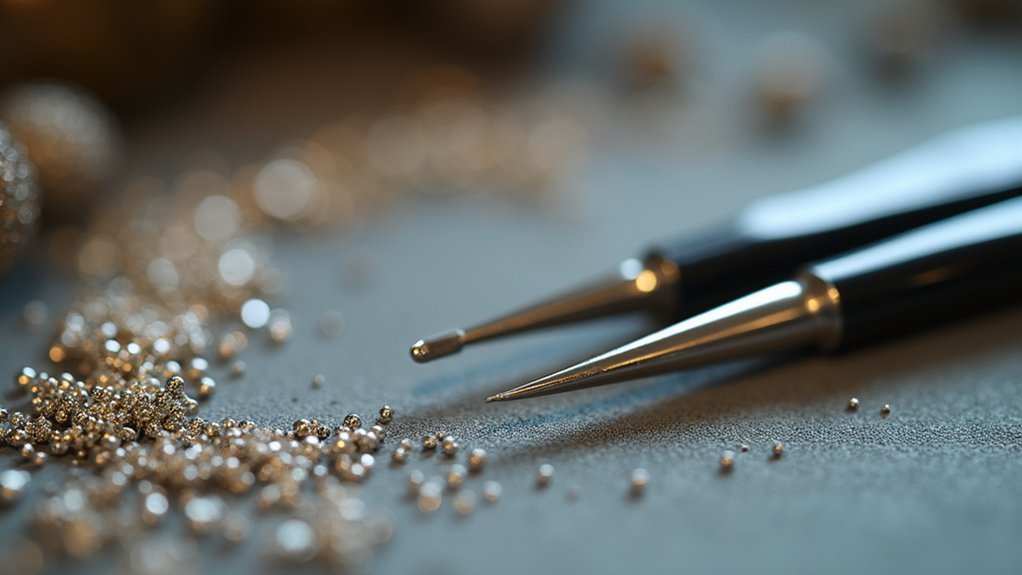
Precision remains paramount when working with the delicate components of filigree and granulation, making specialized tweezers and placement tools indispensable for any serious jewelry artisan.
You’ll find precision tweezers essential for handling tiny granules and positioning filigree elements with accuracy during intricate jewelry making processes. Curved or angled tips provide better maneuverability in tight spaces, allowing you to create detailed intricate patterns without disruption.
Specialized placement tools, including brushes and picks, help you arrange components on jewelry surfaces while preserving surrounding designs. High-quality tweezers made from stainless steel or anti-magnetic materials prevent unwanted reactions with precious metals during soldering.
Using the right placement tools greatly enhances your efficiency, reducing misalignment risks and protecting delicate components throughout the granulation and filigree process.
Soldering Equipment and Heating Systems
While precision tweezers help you position delicate components, successful filigree and granulation depend entirely on your mastery of soldering equipment and heating systems.
Mastering your soldering tools and heat control systems is absolutely critical for achieving professional-quality filigree and granulation results.
You’ll need torches that deliver focused heat, with propane, butane, or oxy-acetylene options providing precise temperature control for different bonding requirements. A quality soldering station with adjustable temperature control guarantees you achieve proper melting points without damaging your workpiece.
When heat is applied, flux becomes essential—borax or gum tragacanth mixtures prevent oxidation and improve adhesion of granules and filigree wires.
Your soldering pick positions tiny elements accurately before heating begins. Always work on a fireproof work surface and wear safety goggles to protect yourself from intense heat and fumes during the soldering process.
Wire Forming and Shaping Pliers
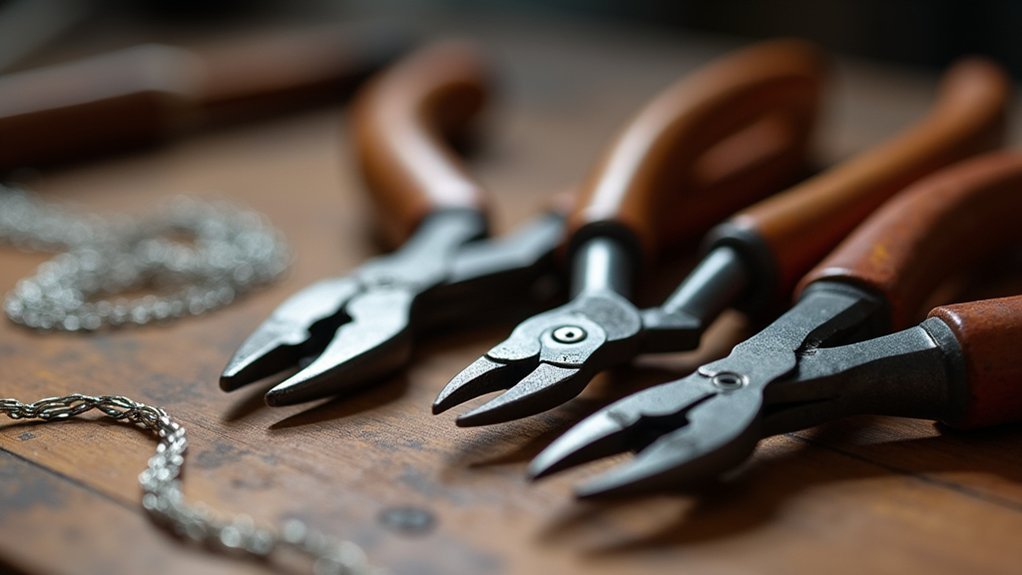
How can you transform straight metal wire into the flowing curves and intricate spirals that define masterful filigree work? Wire forming and shaping pliers are your essential tool for manipulating metal wires with precision.
These specialized pliers come in round-nose and flat-nose varieties, enabling you to bend, twist, and shape wires into complex patterns without damaging their structural integrity.
Quality pliers feature stainless steel construction for durability and an ergonomic design that reduces hand fatigue during extended work sessions.
Whether you’re crafting delicate filigree patterns or preparing elements for granulation, these pliers help you create intricate designs that showcase your artistic vision.
As artisans develop their skills with these tools, they’ll discover enhanced control and the ability to execute increasingly sophisticated metalwork techniques.
Quilling Boards and Pattern Templates
After mastering wire manipulation with quality pliers, you’ll find that quilling boards and pattern templates provide the structural foundation needed to translate your creative vision into precise filigree work.
These specialized corkboard templates feature grid layouts with strategically placed slots and holes that guide your paper strips into consistent shapes and sizes.
You’ll achieve precise placement of every element while maintaining design symmetry throughout your intricate designs.
Pattern templates serve as visual references, helping you replicate complex decorative techniques across multiple pieces.
Many boards offer adjustable features, letting you customize dimensions and vary your patterns.
Cleaning and Finishing Brushes
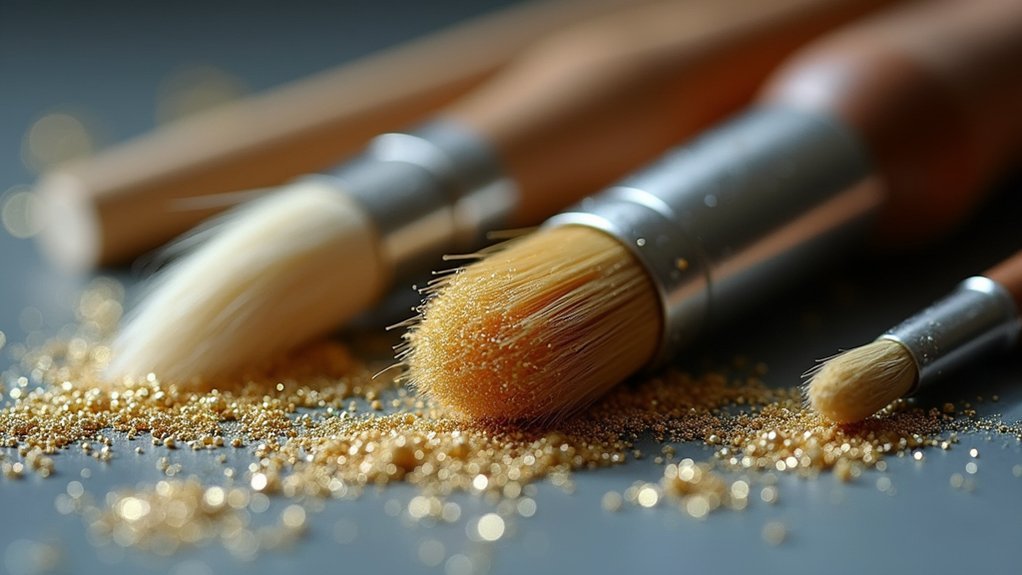
The delicate nature of filigree and granulation work demands specialized cleaning and finishing brushes that can navigate intricate spaces without compromising your carefully crafted details.
You’ll need both cleaning brushes and finishing brushes in various sizes and bristle materials. Choose soft bristles for gentle removal of oxidation and debris from intricate designs, while stiffer options handle more robust scrubbing of metal surfaces.
Clean your pieces using warm soapy water with soft-bristled brushes to preserve metal integrity. For final polishing, use specialized brushes with polishing compounds to enhance shine and luster.
Regular maintenance of your brushes guarantees excellent jewelry finishing results. Always rinse and dry brushes after each use to prevent contamination and extend their lifespan, maintaining consistent performance throughout your filigree and granulation projects.
Flux Application and Mixing Tools
You’ll need to understand different flux types and their specific properties to choose the right formulation for your filigree and granulation work.
Getting the mixing ratios and consistency correct guarantees your flux will hold granules in place while providing proper flow during soldering.
Mastering precision application techniques with the right tools lets you place flux exactly where it’s needed without creating messy excess that interferes with your metalwork.
Flux Types and Properties
When working with granulation and filigree techniques, selecting the right flux becomes critical for achieving clean, precise solder joints without unwanted oxidation. You’ll encounter several flux types, each with distinct properties affecting your soldering success.
| Flux Type | Primary Use | Key Properties |
|---|---|---|
| Borax | General soldering | Acts as binder, high melting points |
| Gum tragacanth | Colloidal soldering | Creates adhesive paste consistency |
| Copper salt mixtures | Fine silver granulation | Reduces oxidation effectively |
| Boric acid solutions | Delicate work | Gentle protective coating |
| Commercial flux pastes | Production work | Consistent performance, ready-to-use |
Understanding each flux’s melting points helps you match them to your specific techniques. Borax works excellently for standard applications, while gum tragacanth mixed with copper salts creates the perfect paste for granulation work on fine silver pieces.
Mixing Ratios and Consistency
Precision in flux mixing determines the success of your granulation and filigree work more than any other preparatory step.
You’ll achieve best results using a 1:2 ratio of tragacanth gum to borax, creating the foundation for effective soldering. Mix these components with distilled water until you reach a smooth, paste-like consistency that spreads easily across your jewelry piece.
The flux mixture should provide strong adhesion without being too thick or runny. Test your consistency by applying it to a practice metal surface—it should hold granules securely without pooling or sliding.
Proper mixing ratios guarantee the flux prevents oxidation while promoting excellent solder flow. Use small brushes or spatulas for precise application, guaranteeing each granule receives adequate coverage for successful bonding during the heating process.
Precision Application Techniques
Since flux application directly impacts the quality of your granulation and filigree bonds, mastering proper tool selection becomes essential for achieving professional results.
You’ll need small brushes, spatulas, or palettes to control flux consistency and prevent clumping during application. These precision application techniques require careful quantity control—excessive flux can dislodge delicate components or obscure your intricate designs.
When working with traditional gum tragacanth and ground borax soldering solution, you’ll achieve better adhesion by maintaining proper mixing ratios.
Your brush selection matters greatly; finer brushes work best for detailed filigree work, while slightly larger tools suit granulation projects.
Remember that skillful flux application directly influences your piece’s aesthetic quality, so practice controlling flow patterns to enhance rather than compromise your metalwork’s visual impact.
Safety Equipment and Workspace Essentials
Before you begin creating delicate filigree patterns or tiny granules, you’ll need to establish a safe workspace that protects both you and your surroundings.
Safety goggles are essential tools that shield your eyes from flying debris and harmful vapors released during the jewelry-making process.
Create a well-ventilated workspace to guarantee proper air circulation when working with soldering materials and fluxes.
Install a fire-resistant work surface like a soldering pad or ceramic tile to prevent accidental fires while using torches.
Keep a first aid kit within reach for addressing minor burns or injuries.
Don’t forget heat-resistant gloves – they’re vital for safely handling hot components during filigree and granulation work, protecting your hands from burns.
Frequently Asked Questions
What Are the Basic Tools Needed for Jewelry Making?
You’ll need pliers for wire manipulation, a soldering torch for joining metals, a jeweler’s saw for cutting, files for smoothing edges, tweezers for precision work, and safety equipment including goggles.
What Are the Techniques of Granulation Jewelry?
You’ll master granulation by fusing tiny gold spheres onto metal surfaces using hard soldering, colloidal soldering, or direct fusing techniques. You’ll need precise heat control, careful granule positioning, and perfect timing to create stunning textured jewelry patterns.
Which Ancient Technique Involves the Use of Tiny Beads or Granules of Metal to Decorate a Jewelry Piece?
You’re looking at granulation, the ancient jewelry-making technique where artisans fuse tiny metal beads or granules onto jewelry pieces to create intricate decorative patterns and textures that’ve adorned precious ornaments for millennia.
What Is the Process of Silver Filigree Making?
You’ll start by drawing fine silver wire to 0.25mm diameter, then twist and shape it into intricate patterns. You’ll solder components using three different melting-point solders, then pickle and polish the finished piece.
In Summary
You’ll find that mastering filigree and granulation requires investing in quality tools that match your artistic ambitions. Don’t compromise on precision tweezers, reliable soldering equipment, or proper safety gear—they’re essential for achieving professional results. Start with the basics and gradually expand your toolkit as your skills develop. Remember, these tools aren’t just equipment; they’re extensions of your creativity that’ll help you transform raw metal into stunning jewelry pieces.

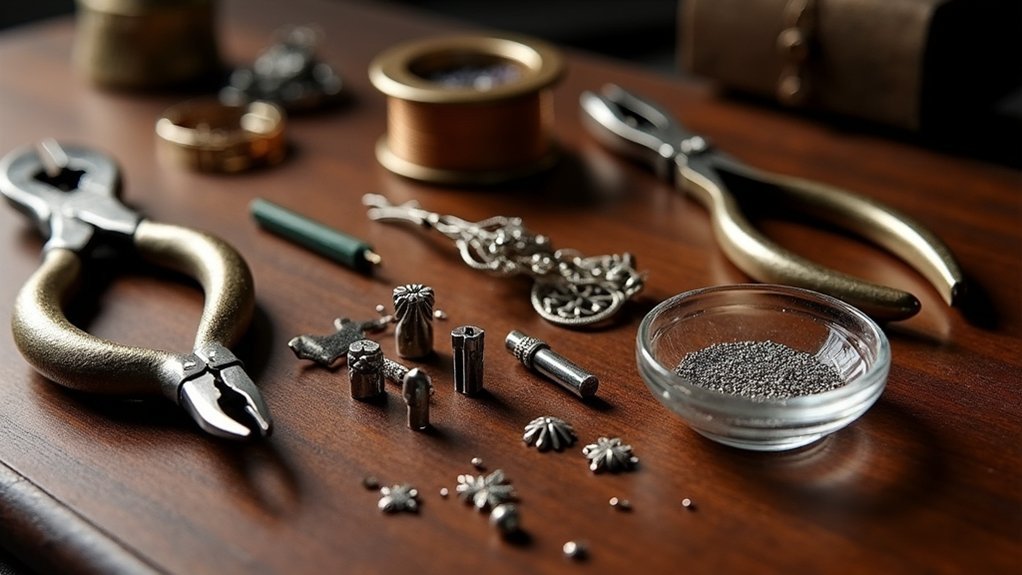
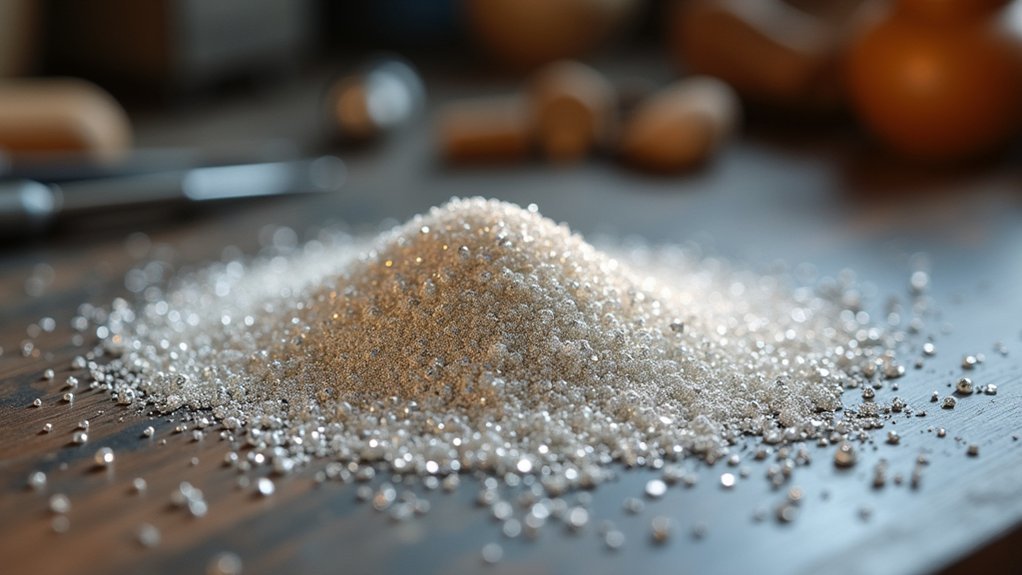
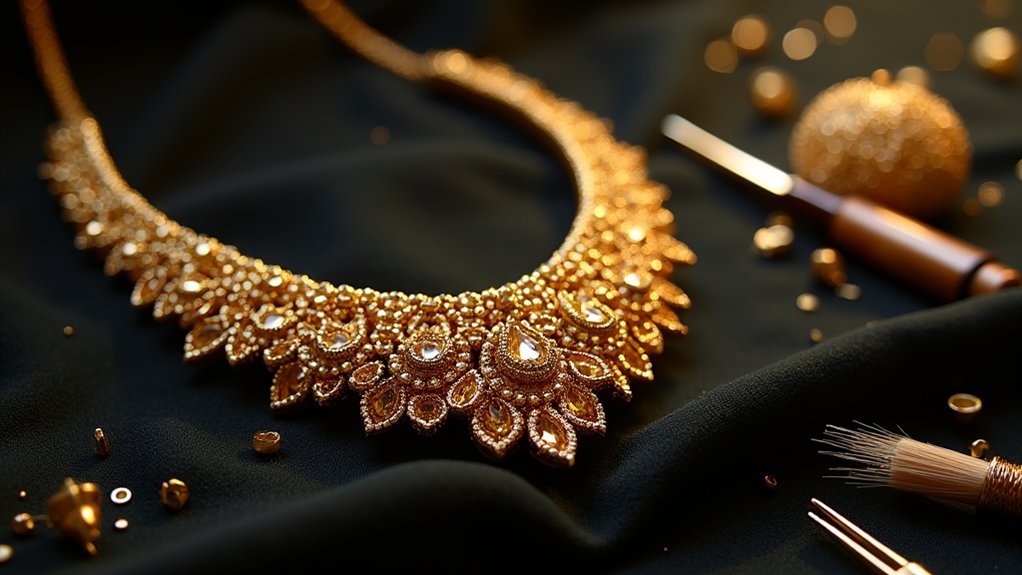
Leave a Reply